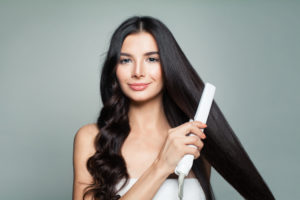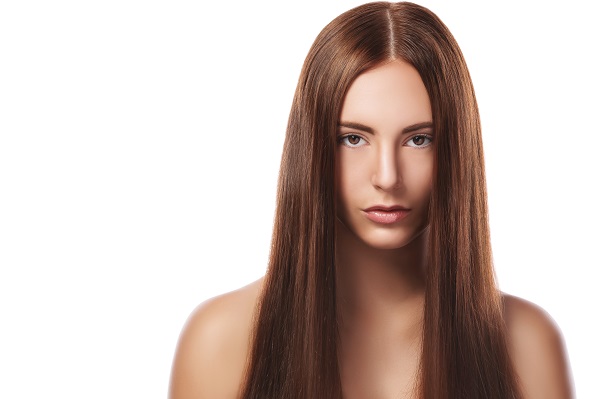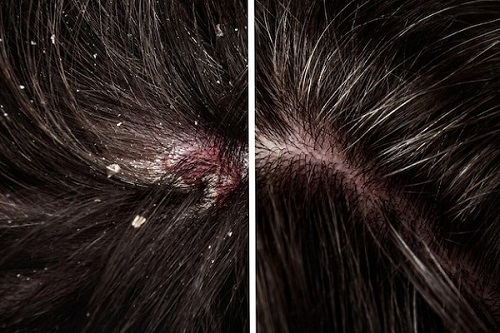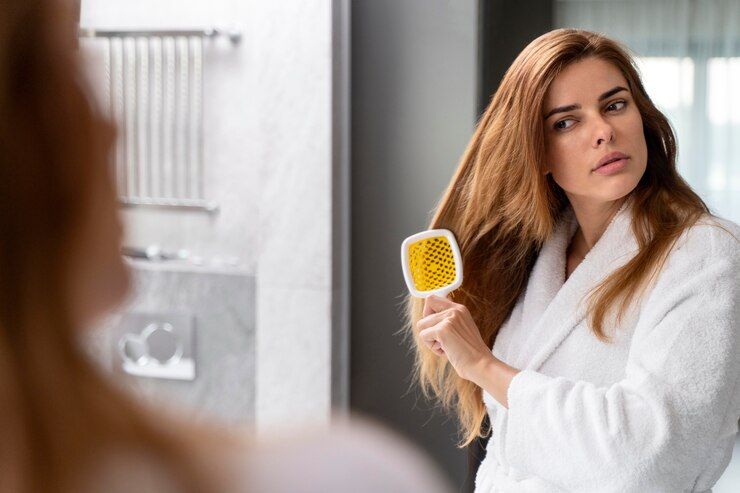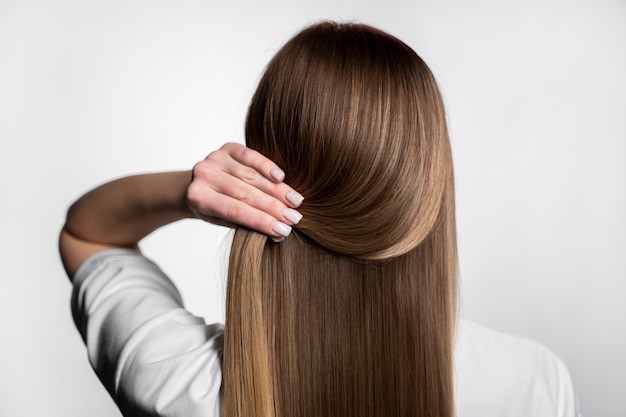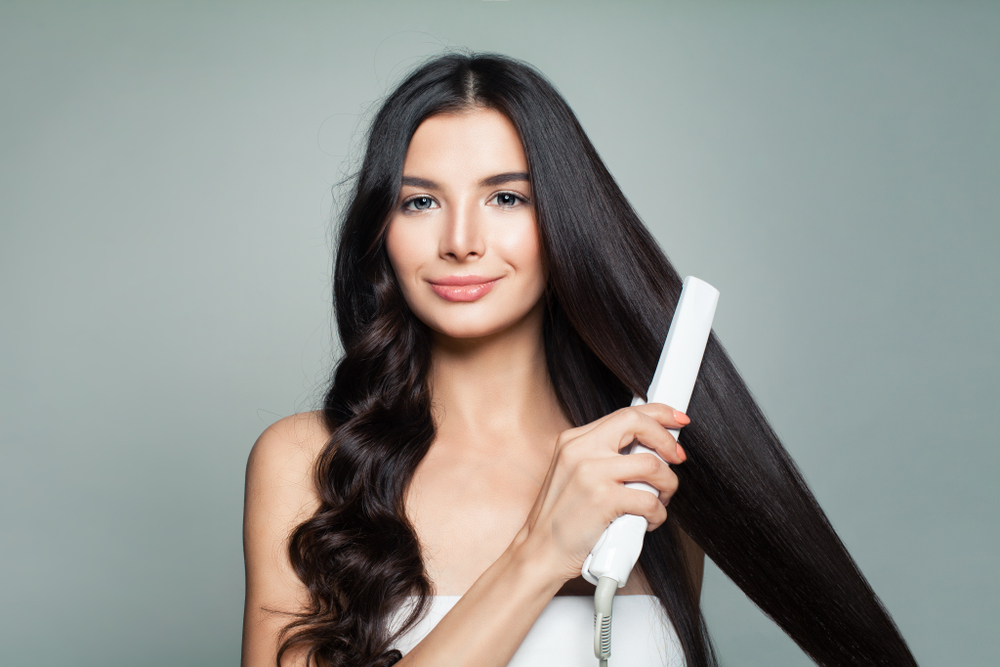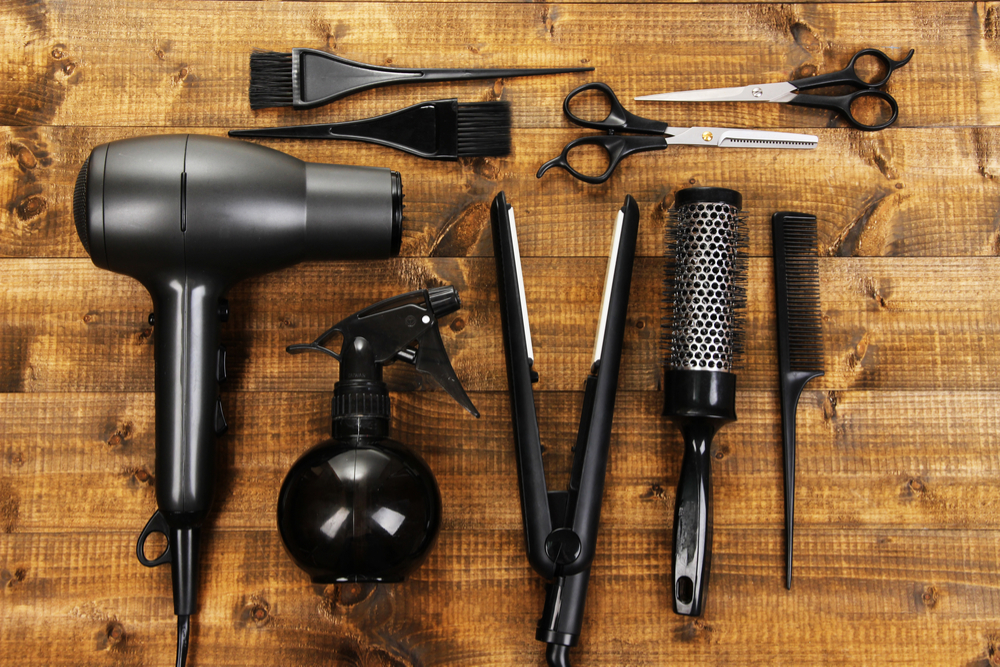Brief explanation of hair growth plateaus
Hair growth plateaus refer to periods during which individuals experience a slowdown or cessation in the growth of their hair. Typically, hair grows in cycles, with active growth phases followed by resting phases. Plateaus occur when the hair follicles enter an extended resting phase, leading to a temporary halt in noticeable growth. Understanding these plateaus is crucial for individuals seeking to maintain healthy and vibrant hair.
Common causes of hair growth plateaus
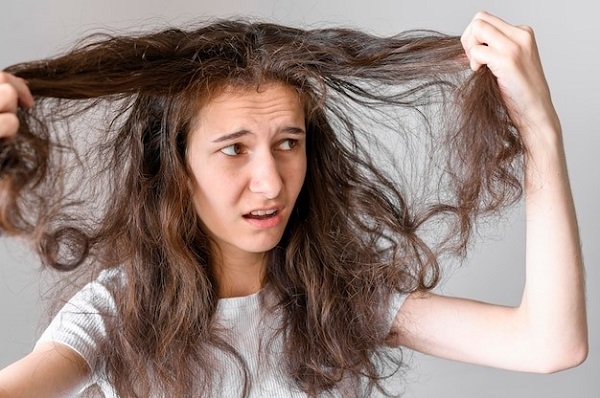
- Genetics: Genetic factors play a significant role in determining hair growth patterns. Some individuals may be genetically predisposed to experience more prolonged resting phases, leading to plateaus in hair growth.
- Hormonal fluctuations: Hormonal changes, such as those during puberty, pregnancy, and menopause, can impact hair growth cycles. Hormonal imbalances may lead to extended resting phases and contribute to hair growth plateaus.
- Nutritional deficiencies: Inadequate intake of essential vitamins and minerals, such as vitamin D, iron, and biotin, can affect the health of hair follicles. Nutritional deficiencies may disrupt the normal hair growth cycle, contributing to plateaus.
- Stress and lifestyle factors: Chronic stress, lack of sleep, and an unhealthy lifestyle can negatively impact hair health. These factors may disrupt the balance of hormones and nutrients necessary for optimal hair growth, leading to plateaus.
- Environmental factors: Exposure to harsh environmental conditions, pollutants, and excessive use of hair styling products can damage hair and impede growth, contributing to growth plateaus.
Importance of understanding and addressing plateaus
- Maintaining hair health: Recognizing and addressing hair growth plateaus is essential for maintaining overall hair health. Identifying the underlying causes allows individuals to take proactive steps to promote healthy hair growth.
- Preventing further damage: Ignoring plateaus may lead to additional stress on hair follicles, potentially causing long-term damage. Understanding the causes helps individuals implement changes to prevent further deterioration.
- Enhancing self-esteem and confidence: Hair plays a significant role in one’s appearance and self-esteem. Addressing growth plateaus and promoting healthy hair growth can positively impact an individual’s confidence and well-being.
- Customized treatment approaches: Different causes require specific interventions. By understanding the underlying factors contributing to plateaus, individuals can tailor their approach to address the root causes effectively, whether through dietary changes, lifestyle adjustments, or targeted treatments.
Understanding Hair Growth
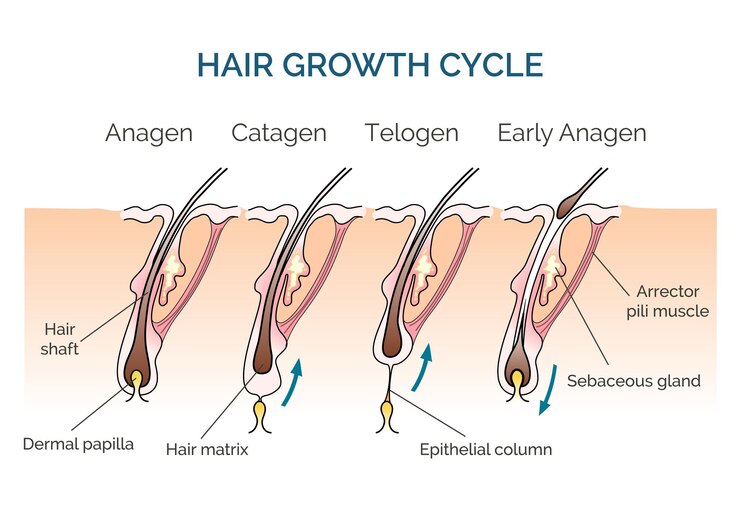
1. Anagen Phase: This is the active growth phase, where hair cells rapidly divide, and hair grows. The duration of the anagen phase varies among individuals, influencing the overall length of their hair.
2. Catagen Phase: A transitional phase that marks the end of active growth. During this phase, the hair follicle shrinks, and the hair detaches from the blood supply.
3. Telogen Phase: The resting phase, where the hair follicle is dormant. The old hair remains in place while new hair begins to grow beneath it. This phase precedes the shedding of the old hair and the start of a new anagen phase.
Factors influencing hair growth
Genetics:
Genetic factors heavily influence hair growth patterns, including the duration of the anagen phase. Individuals with a family history of slow or extended hair growth may be predisposed to experiencing growth plateaus.
- Hormones:
Hormones play a significant role in regulating the hair growth cycle. Androgens, such as testosterone and dihydrotestosterone (DHT), can influence the length and thickness of hair. Hormonal changes during puberty, pregnancy, and menopause can impact the balance of these hormones and affect hair growth.
- Scalp health:
A healthy scalp provides a conducive environment for hair growth. Conditions such as dandruff, psoriasis, or an overly oily scalp can disrupt the hair growth cycle. Regular cleansing, proper hydration, and addressing scalp issues contribute to optimal hair health.
- Nutrition:
Adequate nutrition is essential for healthy hair growth. Nutrients like biotin, vitamins (especially A and D), iron, and protein play crucial roles in the hair growth cycle. A deficiency in these nutrients can contribute to weakened hair and growth plateaus.
- Lifestyle factors:
Various lifestyle factors can impact hair health:
Stress: Chronic stress can lead to hormonal imbalances, contributing to hair loss or growth plateaus.
Sleep: Lack of sufficient sleep can disrupt the body’s overall functioning, including the hair growth cycle.
Smoking and alcohol consumption: These habits can negatively affect circulation, nutrient absorption, and overall health, impacting hair growth.
Identifying Plateaus
- Slowed hair growth:
One of the primary indicators of a hair growth plateau is a noticeable slowdown in the rate of hair growth. If you observe that your hair is not growing as quickly as it used to or if you see a significant reduction in length over time, it may suggest that you’ve reached a plateau in your hair growth cycle.
- Increased hair shedding:
Experiencing an uptick in hair shedding, where you notice more hair strands falling out than usual, can be a sign of a growth plateau. This may occur during the telogen phase of the hair growth cycle when the old hair is shed to make way for new growth. However, an excessive increase in shedding might indicate a disruption in the normal cycle.
- Lack of improvement despite efforts:
If you’ve implemented changes to your hair care routine, lifestyle, or diet in an effort to promote hair growth but see no positive results, it could be an indication that you’ve hit a plateau. Despite your best efforts, the underlying factors contributing to the plateau may not have been effectively addressed.
It’s important to note that hair growth plateaus can be temporary or indicative of an underlying issue. Monitoring these signs can help individuals assess the effectiveness of their current hair care practices and prompt them to investigate potential causes.
In addition to these signs, individuals may also consider tracking the following:
- Scalp condition: Any persistent scalp issues, such as dryness, itchiness, or redness, may contribute to a plateau in hair growth.
- Changes in hormonal balance: Keep an eye on any significant changes in hormonal balance, especially during life events such as pregnancy, menopause, or changes in contraceptive methods.
- Nutrient deficiencies: If you suspect a plateau, it may be beneficial to assess your diet and ensure that you are receiving adequate nutrition, especially essential vitamins and minerals for hair health.
Common Causes of Plateaus
Hormonal imbalances
Thyroid disorders, such as hypothyroidism or hyperthyroidism, can disrupt the balance of hormones in the body. An underactive or overactive thyroid can lead to changes in hair growth patterns, potentially causing growth plateaus.
Polycystic ovary syndrome (PCOS):
PCOS is a hormonal disorder that can affect women of reproductive age. Elevated levels of androgens associated with PCOS can lead to symptoms such as increased hair shedding and slowed hair growth, contributing to growth plateaus.
Nutritional deficiencies:
Iron:
Iron deficiency can result in anemia, affecting the body’s ability to transport oxygen and nutrients to cells, including hair follicles. Insufficient iron levels may lead to weakened hair and a halt in growth.
Vitamin D:
Vitamin D plays a crucial role in hair follicle health. Deficiencies in vitamin D have been linked to hair loss and growth plateaus. Ensuring adequate exposure to sunlight and/or supplementation may be necessary.
B-vitamins:
B-vitamins, including biotin, are essential for hair health. A deficiency in these vitamins can lead to hair thinning and slowed growth. Incorporating foods rich in B-vitamins or supplements may help address this cause.
Scalp conditions
Dandruff is a common scalp condition characterized by flaking and itching. The inflammation associated with dandruff can disrupt the normal hair growth cycle, contributing to growth plateaus.
Psoriasis is a chronic skin condition that can affect the scalp, causing red, scaly patches. The inflammation and rapid turnover of skin cells associated with psoriasis may interfere with the hair growth cycle.
Hair care practices
Excessive use of heat styling tools, such as flat irons and curling irons, can damage the hair shaft and lead to breakage. This damage can contribute to a slowdown in hair growth and create a plateau in overall hair health.
Chemical treatments like bleaching, perming, or relaxing can weaken the hair structure and make it more prone to breakage. Continuous exposure to harsh chemicals can contribute to growth plateaus and compromise the overall health of the hair.
Breaking Through Plateaus: What to Do
Hormone testing:
Schedule a consultation with a healthcare professional to assess hormonal levels, especially if you suspect hormonal imbalances. Hormone testing can help identify issues related to thyroid function, androgens, or other hormones that may be contributing to the hair growth plateau.
Blood work for nutritional deficiencies:
A comprehensive blood test can reveal any nutritional deficiencies that may be impacting hair health. Testing for iron levels, vitamin D, and B-vitamins can provide valuable insights into potential dietary adjustments needed to support optimal hair growth.
Adjusting your diet for hair health

Incorporate a balanced diet rich in nutrients essential for hair health. Include foods high in iron (lean meats, legumes), vitamin D (fatty fish, fortified dairy), and B-vitamins (whole grains, leafy greens) to support the hair growth cycle.
Importance of hydration:
Proper hydration is crucial for overall health, including hair health. Drinking an adequate amount of water helps maintain scalp health and supports the transport of nutrients to hair follicles, promoting optimal growth.
Revamping your hair care routine
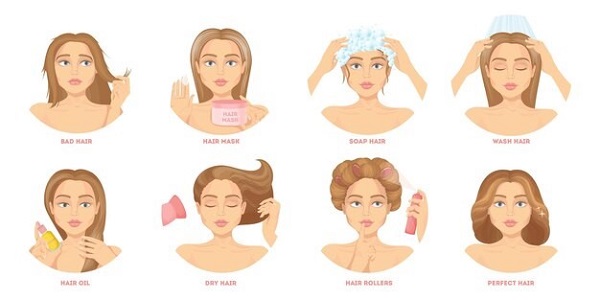
- Gentle washing and conditioning:
Use mild, sulfate-free shampoos and conditioners to avoid stripping the hair of natural oils. Overwashing can contribute to dryness and breakage, hindering the hair growth cycle.
- Avoiding harsh chemicals:
Minimize the use of harsh chemical treatments, such as bleaching, perming, or relaxing. Opt for gentler alternatives and give your hair time to recover from any previous damage.
- Incorporating scalp massages:
Stimulate blood circulation to the scalp through gentle massages. This promotes a healthy environment for hair growth by ensuring that nutrients reach the hair follicles.
Introducing hair growth supplements
Biotin:
Biotin, a B-vitamin, is known for its role in promoting healthy hair, skin, and nails. Consult with a healthcare professional before starting a biotin supplement to ensure it is appropriate for your individual needs.
Omega-3 fatty acids:
Omega-3 fatty acids, found in fish oil and flaxseed, have anti-inflammatory properties that can benefit the scalp and hair follicles. Adding omega-3 supplements to your diet may support overall hair health.
Breaking through a hair growth plateau requires a multifaceted approach that addresses underlying issues. By consulting with healthcare professionals, making dietary adjustments, revamping your hair care routine, and considering targeted supplements, you can create a comprehensive strategy to promote healthier and more vibrant hair growth.
Patience and Consistency

Realistic expectations for results:
Understand that breaking through a hair growth plateau is a gradual process, and results may not be immediate. Hair growth is influenced by various factors, and changes take time to manifest. Set realistic expectations for the timeline of improvement, keeping in mind that individual responses may vary.
The importance of consistency in new habits:
Consistency is key when implementing changes to address a hair growth plateau. Whether it’s adjusting your diet, revamping your hair care routine, or taking supplements, consistency in new habits allows the body and hair follicles to adapt and respond positively. Stick to your new practices for an extended period to see lasting improvements.
Monitoring progress and adjusting as needed:
Regularly monitor the progress of your hair growth journey. Keep track of changes in hair texture, thickness, and overall health. If you observe positive results, it indicates that your efforts are paying off. However, if progress is slow or nonexistent, consider adjusting your approach.
Be flexible and willing to make further modifications to your routine based on your hair’s response. If certain dietary changes or supplements aren’t yielding the desired results, consult with healthcare professionals for guidance on potential adjustments.
Remember, breaking through a hair growth plateau requires patience, and results may vary from person to person. It’s essential to focus on the overall health of your hair and make sustainable lifestyle changes. Celebrate small victories along the way, and acknowledge that consistent, positive habits contribute to long-term improvements in hair growth and health. If uncertainty persists, seeking guidance from healthcare professionals or dermatologists can provide personalized insights and recommendations.
Innovative Hair Care Solution: Ultimate Cheveux®
For those seeking an advanced and professional solution to overcome hair growth plateaus, the Ultimate Cheveux® system by the FloClaire Group offers a groundbreaking approach. This specialized hair restoration and retention system are designed to care for hair by restoring its natural physiological balance and overall wellness, addressing the root causes of growth plateaus.
Tolerability and Gentleness:
This characteristic makes the system not only effective in hair restoration but also suitable for everyday use.
Restoration and Stimulation:
This innovative approach works by reducing hair loss through the activation of dermal papilla cells, thereby stimulating natural hair growth.
Proprietary Organic Blend:
These extracts work in synergy with other active ingredients, creating a harmonious combination that addresses various aspects of hair health.
Products in the Ultimate Cheveux® Line:
- Multiactive Rebalancing Conditioner
- Multiactive Restructuring Shampoo
- Keratin Hair Growth Elixir
- Texture Lock Serum

Customized Treatment with Ultimate Cheveux®:
The Ultimate Cheveux® system offers a comprehensive and customized approach to hair care. Whether you’re dealing with genetic factors, hormonal imbalances, nutritional deficiencies, or environmental stressors, the tailored formulations of Ultimate Cheveux® aim to address specific issues, promoting healthier and more vibrant hair growth.
Conclusion
To those currently navigating the challenges of hair growth plateaus, it’s crucial to recognize that each journey is unique. Plateaus are temporary, and with patience, consistency, and a tailored approach, positive changes can occur. Seeking guidance from healthcare professionals, making informed lifestyle choices, and maintaining a positive mindset are essential components of the process.
By combining the knowledge of hair growth plateaus with the innovative approach of Ultimate Cheveux®, individuals can empower themselves to break through plateaus and enjoy a renewed sense of confidence and well-being. Embrace a holistic approach to hair health, understanding the intricacies of the hair growth cycle, identifying plateaus, and implementing targeted strategies for improvement. Your journey to healthier hair is not just about external practices but also encompasses internal factors such as nutrition, hormonal balance, and overall well-being. By acknowledging the interconnectedness of these elements and making informed choices, individuals can embark on a fulfilling journey towards achieving and maintaining vibrant and healthy hair.

